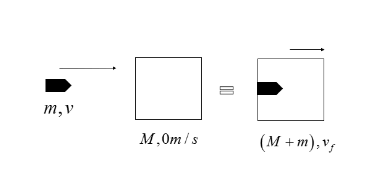
A bullet of mass \[m\] moving with a velocity \[v\]strikes a block of mass \[M\]at rest and gets embedded to it. The kinetic energy of the composite block will be
\[\begin{align}
& A)\dfrac{1}{2}m{{v}^{2}}\times \dfrac{m}{\left( m+M \right)} \\
& B)\dfrac{1}{2}m{{v}^{2}}\times \dfrac{M}{\left( m+M \right)} \\
& C)\dfrac{1}{2}m{{v}^{2}}\times \dfrac{\left( m+M \right)}{M} \\
& D)\dfrac{1}{2}m{{v}^{2}}\times \dfrac{\left( m+M \right)}{m} \\
\end{align}\]
Answer
578.1k+ views
Hint: We will use the law of conservation of momentum which is given as initial momentum of the system will be equal to final momentum of the system to determine the final velocity of the combined block. Then we will use the expression for kinetic energy to find the kinetic energy of the given system using the velocity we found. Kinetic energy is directly proportional to mass and square of the velocity of the body.
Formula used:
\[\begin{align}
& {{m}_{1}}{{u}_{1}}+{{m}_{2}}{{u}_{2}}={{m}_{1}}{{v}_{1}}+{{m}_{2}}{{v}_{2}} \\
& K.E=\dfrac{1}{2}m{{v}^{2}} \\
\end{align}\]
Complete step by step answer:
Firstly we will draw a diagram for understanding the situation better.

Here, the mass of the bullet is taken as \[m\].
Mass of the block is taken as \[M\].
Velocity of the bullet is taken as \[v\].
And velocity of the block is zero as it is initially at rest.
Now, we will use the law of conservation of momentum to find the velocity of the combined block whose mass will be \[M+m\]. That is,
\[mv+M\times 0=\left( m+M \right){{v}_{f}}\]
\[\begin{align}
& \Rightarrow mv=\left( m+M \right){{v}_{f}} \\
& \Rightarrow {{v}_{f}}=\dfrac{m}{\left( m+M \right)}v \\
\end{align}\]
So, the final velocity of the combined block is found to be, \[{{v}_{f}}=\dfrac{m}{\left( m+M \right)}v\].
Now, we will use this velocity to find the kinetic energy of the combined block. Kinetic energy is given as,
\[K.E=\dfrac{1}{2}m{{v}^{2}}\]
We have the mass of the combined block as \[M+m\].
\[\begin{align}
& \Rightarrow K.E=\dfrac{1}{2}\left( m+M \right){{\left( \dfrac{m}{\left( m+M \right)}v \right)}^{2}} \\
&\Rightarrow K.E=\dfrac{1}{2}\left( m+M \right)\times \dfrac{{{m}^{2}}}{{{\left( m+M \right)}^{2}}}{{v}^{2}} \\
& \Rightarrow K.E=\dfrac{1}{2}m{{v}^{2}}\times \dfrac{m}{\left( m+M \right)} \\
\end{align}\]
Hence, we have found the kinetic energy of composite block as\[\dfrac{1}{2}m{{v}^{2}}\times \dfrac{m}{\left( m+M \right)}\].
Hence, the correct answer is option A.
Note:
We must be very careful while doing problems like this. The sign of velocity has a major role in determining the momentum. In this case the velocity of all the objects and systems is in the same direction which we have taken as positive. But we must remember that we will need to use sign convention if any of the colliding particles or the composite system has a change in direction in velocity.
Formula used:
\[\begin{align}
& {{m}_{1}}{{u}_{1}}+{{m}_{2}}{{u}_{2}}={{m}_{1}}{{v}_{1}}+{{m}_{2}}{{v}_{2}} \\
& K.E=\dfrac{1}{2}m{{v}^{2}} \\
\end{align}\]
Complete step by step answer:
Firstly we will draw a diagram for understanding the situation better.

Here, the mass of the bullet is taken as \[m\].
Mass of the block is taken as \[M\].
Velocity of the bullet is taken as \[v\].
And velocity of the block is zero as it is initially at rest.
Now, we will use the law of conservation of momentum to find the velocity of the combined block whose mass will be \[M+m\]. That is,
\[mv+M\times 0=\left( m+M \right){{v}_{f}}\]
\[\begin{align}
& \Rightarrow mv=\left( m+M \right){{v}_{f}} \\
& \Rightarrow {{v}_{f}}=\dfrac{m}{\left( m+M \right)}v \\
\end{align}\]
So, the final velocity of the combined block is found to be, \[{{v}_{f}}=\dfrac{m}{\left( m+M \right)}v\].
Now, we will use this velocity to find the kinetic energy of the combined block. Kinetic energy is given as,
\[K.E=\dfrac{1}{2}m{{v}^{2}}\]
We have the mass of the combined block as \[M+m\].
\[\begin{align}
& \Rightarrow K.E=\dfrac{1}{2}\left( m+M \right){{\left( \dfrac{m}{\left( m+M \right)}v \right)}^{2}} \\
&\Rightarrow K.E=\dfrac{1}{2}\left( m+M \right)\times \dfrac{{{m}^{2}}}{{{\left( m+M \right)}^{2}}}{{v}^{2}} \\
& \Rightarrow K.E=\dfrac{1}{2}m{{v}^{2}}\times \dfrac{m}{\left( m+M \right)} \\
\end{align}\]
Hence, we have found the kinetic energy of composite block as\[\dfrac{1}{2}m{{v}^{2}}\times \dfrac{m}{\left( m+M \right)}\].
Hence, the correct answer is option A.
Note:
We must be very careful while doing problems like this. The sign of velocity has a major role in determining the momentum. In this case the velocity of all the objects and systems is in the same direction which we have taken as positive. But we must remember that we will need to use sign convention if any of the colliding particles or the composite system has a change in direction in velocity.
Recently Updated Pages
Master Class 12 Business Studies: Engaging Questions & Answers for Success

Master Class 12 Economics: Engaging Questions & Answers for Success

Master Class 12 English: Engaging Questions & Answers for Success

Master Class 12 Maths: Engaging Questions & Answers for Success

Master Class 12 Social Science: Engaging Questions & Answers for Success

Master Class 12 Chemistry: Engaging Questions & Answers for Success

Trending doubts
What is meant by exothermic and endothermic reactions class 11 chemistry CBSE

Which animal has three hearts class 11 biology CBSE

10 examples of friction in our daily life

One Metric ton is equal to kg A 10000 B 1000 C 100 class 11 physics CBSE

1 Quintal is equal to a 110 kg b 10 kg c 100kg d 1000 class 11 physics CBSE

Difference Between Prokaryotic Cells and Eukaryotic Cells




